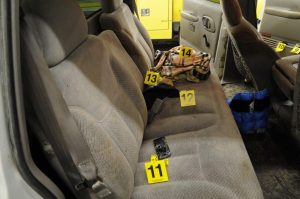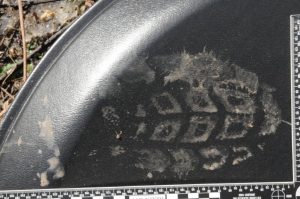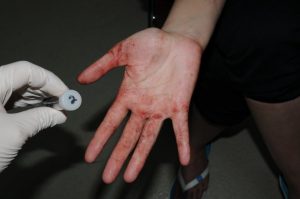
“Without a doubt, it is getting harder and harder to get away with crime,” this from Trent Emigh, the Staff Sergeant of the SPS Forensic Identification Unit. Trent has worked in the unit for 2.5 years, but has been investigating crime scenes throughout his career. He became an officer with the Saskatoon Police Service in 1985.
The Saskatoon Police Service Forensic Identification Unit, commonly referred to as “Ident,” works closely with Patrol officers and the Criminal Investigation Division (CID) throughout their investigations. Ident is responsible for attending crime scenes to document evidence with photos and videos, collecting and processing evidence, documenting victims’ injuries and attending autopsies, submitting evidence to the RCMP Forensic Lab and securely storing exhibits during court proceedings. The unit also collects and stores criminal, as well as some civilian, fingerprints.

Crime scenes are processed by Ident for evidence relating to the identity of the suspect and/or to connect the suspect to the crime. What the investigators look for are viable DNA sources; blood, saliva (cigarette butts, gum, etc.), semen, sweat, dead skin, hair, fingerprints as well as shoe and tire prints. DNA is essentially a biological fingerprint.
One of the most beneficial aspects of Ident is the National DNA Data bank full of hundreds of thousands of people’s DNA that will never expire. If the same DNA is found at a different crime scene, the investigators can link multiple crimes often leading to a stronger case in court against a suspect. Emigh has seen it in action. “The most I am personally aware of is one offender who was linked by DNA to seven different scenes; three were from British Columbia, two were from Alberta and two were from Saskatchewan.”

DNA stands as solid evidence, but it’s not quick evidence…although many people have fallen victim to the “CSI Effect.” Crimes on T.V. dramas can be solved in seconds!…often using a hologram. That’s not how it works. Results take time. The DNA sample has to be sent away to a lab for analysis and results typically come back in 90 days.
DNA not only assists in solving recent crimes, but also historical crimes. “In Policing, there can be some challenges in pursuing historical charges, however DNA is sound and incredibly powerful evidence.” Emigh recalls a case from 2005; Police investigated three separate break-and-enters where the suspect had conveniently left his saliva behind. Unfortunately at the time, there was no matching offender profile in the DNA data bank. But this offender wasn’t a one-hit wonder. He committed another offence earlier this year. Once his DNA was submitted for analysis, investigators were able to link him to his previous crimes. He’s facing charges relating to those three, 12 year old B&E’s, as well as his most recent crime.

The National DNA data bank is growing as quickly as people are committing crimes. DNA profiles may soon be developed from exhibits that were previously deemed insufficient, as technology evolves. 3-D cameras and software now allow for more efficient recording of crime scenes, evidence and mapping. At the end of the day, innovations in technology and a growing DNA data bank are only making the career of a criminal less and less viable.
This post was originally published on November 8, 2017 on the Saskatoon Police Service Blog.